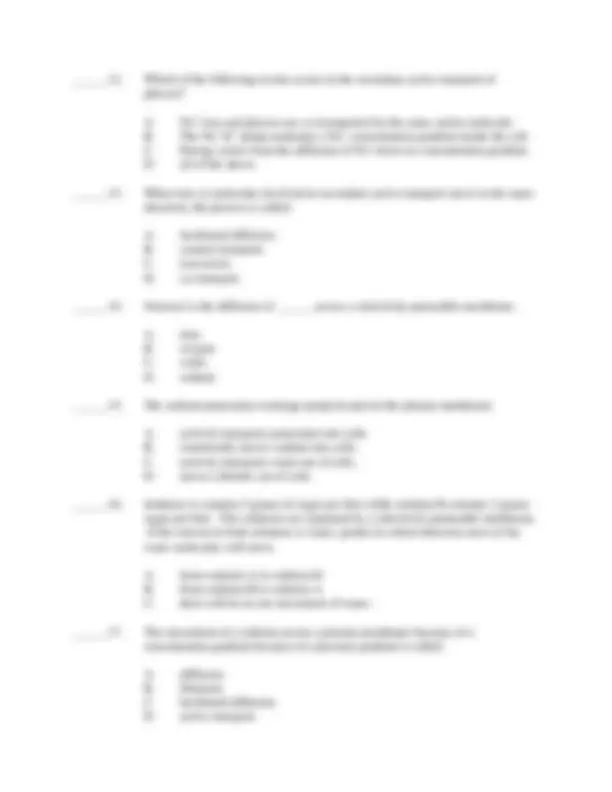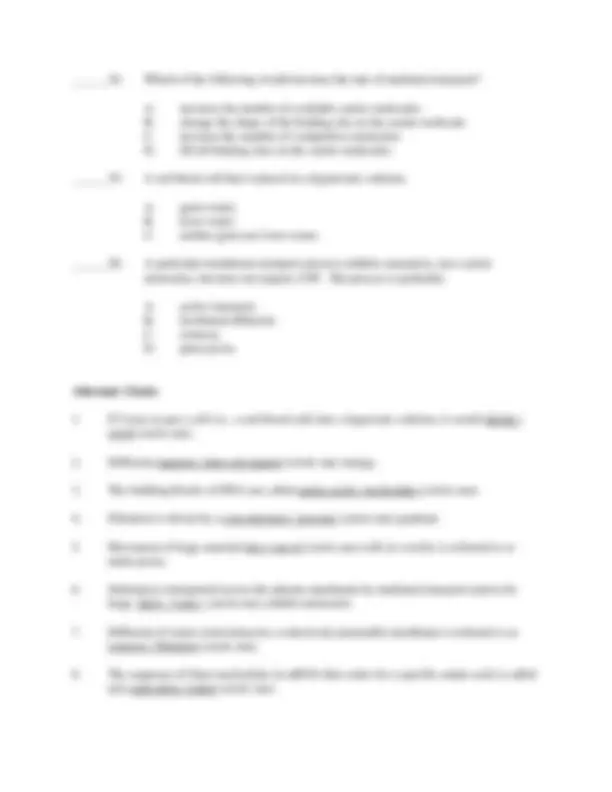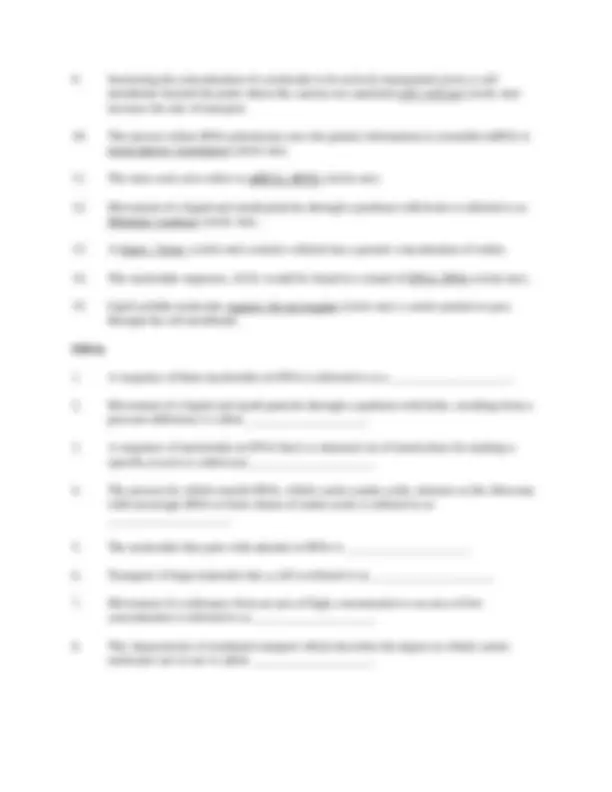





Study with the several resources on Docsity

Earn points by helping other students or get them with a premium plan


Prepare for your exams
Study with the several resources on Docsity

Earn points to download
Earn points by helping other students or get them with a premium plan
Community
Ask the community for help and clear up your study doubts
Discover the best universities in your country according to Docsity users
Free resources
Download our free guides on studying techniques, anxiety management strategies, and thesis advice from Docsity tutors
A chapter from a human physiology for sports medicine textbook focusing on the plasma membrane and various transport systems. It includes multiple choice questions covering topics such as the structure and function of the plasma membrane, osmosis, diffusion, and active and facilitated transport.
Typology: Exams
1 / 7

This page cannot be seen from the preview
Don't miss anything!




SPMD 202 – Human Physiology for Sports Medicine Physiology of Cells Chapter 3
Multiple Choice
______1. The plasma membrane:
A. separates the nucleus from the rest of the cell. B. is a rigid protein membrane. C. regulates the movement of materials into and out of the cell. D. has a single layer of phospholipids.
______2. The environment outside of the cell is most appropriately referred to as:
A. intracellular. B. extracellular. C. multicellular. D. centrocellular.
______3. The fluid mosaic model of the plasma membrane suggests that:
A. cholesterol forms the outermost layer of the membrane. B. proteins form a “liquid” sea in the membrane. C. phospholipids form a single lipid layer in the center of the membrane. D. the membrane is neither rigid nor static in structure.
______4. Plasma membrane phospholipids:
A. have polar (charged) tails. B. form a bilayer. C. have tails that face the exterior of the membrane. D. are 95% cholesterol.
______5. Messenger RNA:
A. is synthesized when a portion of a DNA molecule is transcribed. B. directs the synthesis of DNA. C. determines the sequence of nucleotides in the anticodons of tRNA. D. directs the synthesis of centrioles in the cytoplasm.
______6. The transfer of information from DNA to mRNA is known as:
A. transduction. B. translocation. C. translation. D. transcription.
______7. Which of the following sequences is correct?
A. translation → protein synthesis → transcription B. transcription → translation → protein synthesis C. transcription → protein synthesis → translation D. translation → transcription → protein synthesis
______8. Translation:
A. requires three types of DNA. B. requires the pairing of codons on mRNA with anticodons on tRNA. C. involves the synthesis of RNA from DNA molecules. D. takes place in the nucleus.
______9. A DNA base sequence is A-T-G-C-C-G. The sequence of bases in a strand of mRNA transcribed from this sequence of bases in DNA would be:
A. T-A-C-G-G-C. B. U-T-C-G-G-U. C. U-A-C-G-G-C. D. A-U-G-C-C-G.
______10. Endocytosis:
A. is the movement of water through a selectively permeable membrane. B. is a process that requires a carrier molecule but does not use cellullar energy. C. is the bulk uptake of material through the plasma membrane by vesicle formation. D. moves material out of the cell.
______11. Pinocytosis:
A. is a form of exocytosis. B. involves the ingestion of liquids rather than particles. C. does not require ATP. D. forms vesicles only when large amounts of material are being transported.
______18. Which of the following would increase the rate of mediated transport?
A. increase the number of available carrier molecules B. change the shape of the binding site on the carrier molecule C. increase the number of competitive molecules D. fill all binding sites on the carrier molecules
______19. A red blood cell that is placed in a hypertonic solution,
A. gains water. B. loses water. C. neither gains nor loses water.
______20. A particular membrane transport process exhibits saturation, uses carrier molecules, but does not require ATP. The process is probably:
A. active transport. B. facilitated diffusion. C. osmosis. D. pinocytosis.
Alternate Choice
Fill-In
Multiple Choice
Alternate Choice
Fill-In